Parks
Tennessee cities also developed public parks, which offered scenic views and leisurely walks for their residents.
Overton Park Zoo in Memphis was constructed in 1905. A bear was the main attraction, with an elephant added the next year. Riverside Park was also opened in Memphis in 1902.
In Nashville, Glendale Park was opened in 1887 around the trolley line. It cost a nickel to ride to the park from anywhere in the city.
At various times there was a casino, roller rink, Merry-Go-Round, croquet grounds, a zoo, shooting galleries and a bandstand located at the park. Balloon ascensions were advertised each Sunday in October 1900 with band concerts from 2 to 6 p.m.
Percy and Edwin Warner Parks were given to the city of Nashville by Percie and Luke Lea in honor of her father Percy Warner and her uncle, Edwin. The parks opened in 1927 and together are the largest city parks in the state.
African Americans were excluded from using public parks in the state. Several African American leaders and philanthropists privately built and financed parks for African Americans to use.
In Memphis in 1899, Robert Church built Church Park and Auditorium for the city’s black residents. The new facility could hold 2,000 people, and popular musician W. C. Handy was hired as the official orchestra director. Additionally, white leaders finally approved the construction of Douglass Park in 1913 for blacks after years of lobbying by the African American community.
In Nashville, community leaders helped establish the privately-owned Greenwood Park, created solely for African Americans to use. Later, Mayor Hilary Howse would become the first official in the country to provide a city park, Hadley Park, for African Americans in 1912.
State and national parks also became popular during the period. East Tennesseans held a National Conservation Expo in 1913, which was sponsored by President Theodore Roosevelt. The exposition was held in Knoxville at Chilhowee Park.
Local residents often played major roles in natural conservation as well. In 1919 geologist Wilbur Nelson urged for the conservation of such majestic areas as Reelfoot Lake and Brushy Mountain. In response to these and other people, the state legislature established the State Park and Forestry Commission in 1925.
Major conservation plans during this period were usually done by the federal government. In 1920 the U.S. Forest Service purchased land in East Tennessee to establish Unaka, Pisgah, and Cherokee parks.
Preserving the Great Smoky Mountains was proposed by East Tennesseans. Several people helped organize the Great Smoky Mountains Conservation Association.
This group began to publicize the need for a national park and recruit interested workers. One local advertisement read:
|
What Would a National Park in the Smokies Be Worth to You?
But every man, women, and child in East Tennessee will benefit directly by the establishment of a national park in this section. They will benefit financially as well as from the standpoint of the pleasure, health and enlightenment that close access to such a park will bring. |
Local supporters held fundraisers. By 1926 Knoxville residents had given over one million dollars for the project. The following year the General Assembly appropriated two million to purchase land for the park. John D. Rockefeller, a wealthy New Yorker, donated the last $5 million.
However, efforts were stalled when timber companies resisted the sale of their lands and the Great Depression began. Several communities had to be relocated. Some families had to also be forcibly removed from their land holdings. As a result, the park would not officially open until 1940.
Picture Credits:
- Photograph of a building at Warner Park. This photo was taken in 1917 in Chattanooga. It shows a small group of people in front of the Women’s building or Agricultural building during the 1917 fair. Chattanooga-Hamilton County Bicentennial Library.
- Photograph showing an auto race at the Chattanooga Interstate Fair. This photo was taken on October 8, 1921 at Warner Park in Chattanooga. The car in front is named the “Hassler Special” and is driven by Carl Dixon. Chattanooga-Hamilton County Bicentennial Library.
- Photograph of a ferris wheel at the Tri-State Fair. This photo was taken in 1917 in Memphis. It shows people on the amusement ride while others watch from behind a gate. Memphis Public Library and Information Center.
- Photograph entitled, “Midway at Tri-State Fair.” This photo was taken in 1917 in Memphis. It shows a large group of people standing outside of a ride called, “Over the Falls.” Memphis Public Library and Information Center.
- Photograph of the Bear pits in Memphis. This photo was taken sometime between 1900 and 1920. It shows a large group of people looking at a caged bear. Numerous children can also be seen in the photo. Library of Congress.
- Photograph showing people roller skating at Forrest Park. This photo was taken in Memphis in 1906. The statue of Nathan Bedford Forrest can be seen in the background. Library of Congress.
- Photograph of a carnival balloon. This photo was taken in Nashville in 1877. It shows a large crowd of people watching an air balloon ascend. Tennessee State Library and Archives.
- Photograph of the National Conservation Exposition at Chilhowee Park. This photo was taken in Knoxville in 1913. It features the Main Exhibition Hall at night. C. M. McClung Historical Collection, Knox County Public Library.
- Photograph of a couple in a boat on the lake in Electric Park. This photo was taken in 1890 in Chattanooga. Several other people can be seen sitting on the bank of the lake. Chattanooga-Hamilton County Bicentennial Library.
- A photograph of six young women in a row boat on Chilhowee Park Lake in Knoxville probably in the early 1900s. Image number, 200-020-053. Calvin M. McClung Historical Collection, Knox County Public Library
Confronting the Modern Era >> Life in Tennessee >> Having Fun >> Parks
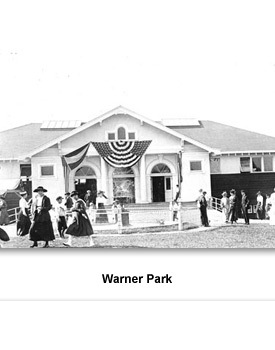
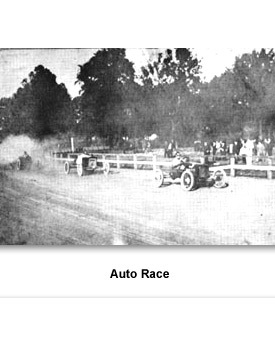
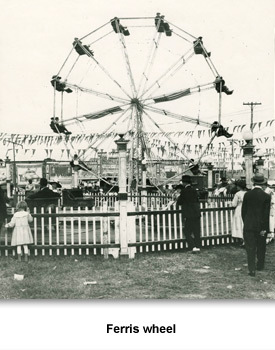
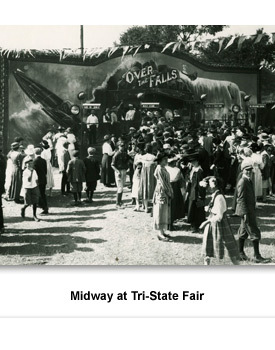
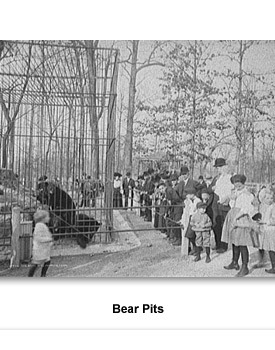
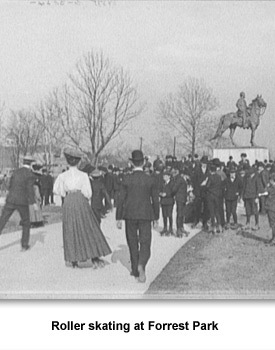
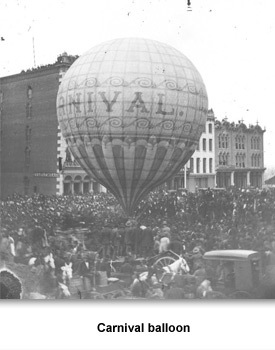
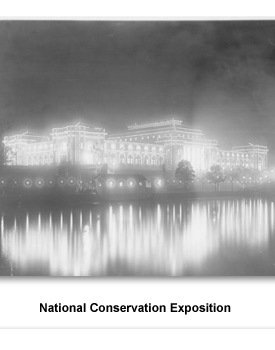
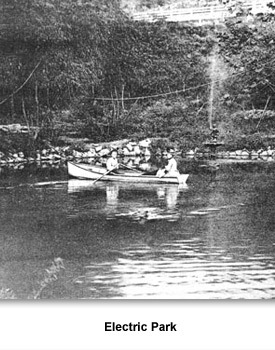
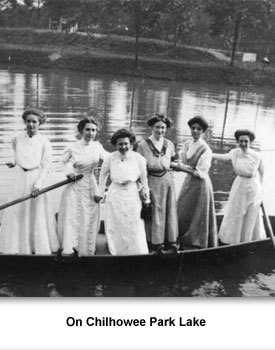
 Sponsored by: National Endowment for the Humanities
Sponsored by: National Endowment for the Humanities